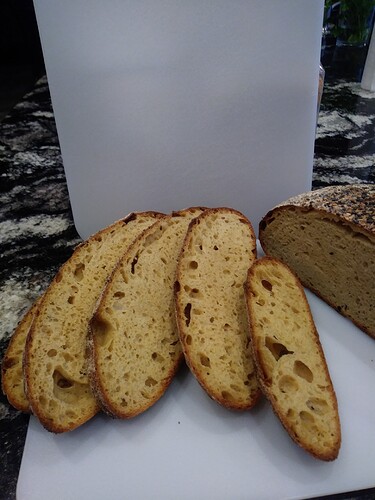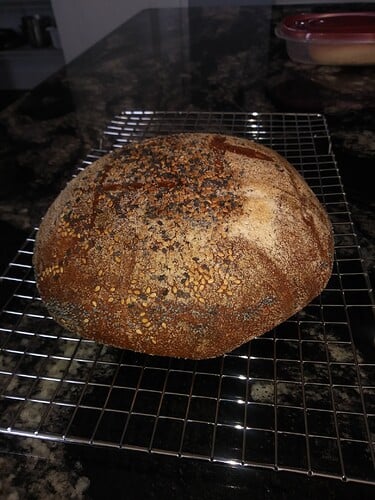Hey Melissa great timing on the whole grain. I also did a trial run yesterday using Durum and White Organic home milled whole Grain in a mix. Turned out to be my best 100% to date as the crumb was outstanding, fairly decent sized rustic sized holes, crispy light crust and the rise was out of sight without using a vessel as it was baked directly on the stone. After tightening up the boule and setting the dough it did flatten out to an inch BUT sprung up 4 inches.
SECRET SAUCE: a large egg
I know from a puritan point of view you don’t put an egg in a rustic sourdough BUT I HAD TO TRY IT!
Used an overnight pre-mix with salt, then mixed the egg into the starter before folding into the pre-mix.
I attached a couple of pictures and yeah my scoring needs help but maybe someday!
I assumed the Durum had a protein level of 10 and the organic white also at 10 so I did some calculations for additions in the recipe below.
The egg really does wonders for giving the dough the extra support it needs to rise. This bread actually had a bit of extra bran included as I had sitting on the counter and it still popped up. No muss or fuss with the bran.
Original Recipe: 100% whole Grain
431 g Whole Wheat Flour (50% with starter) 100%
86 g Organic Durum 20%
3 45 g White Organic
ACTUAL RECIPE FLOUR AMOUNTS Using additions
413g Whole Wheat Flour Home Milled
77g Organic Durum
336g White Organic Spring Wheat
4.3g Barley Malt Powder 1%
18g Vital Wheat Gluten 4.1%
80 g Whole Wheat/Rye Leaven @ 100% Hydration 19%
31 0 g Water (3 50 g with starter water) 81 %
added 12g extra water during mix process, too dry!
1 egg 57g (57x.85=48g actual) 10%
1 0 . 3 g Salt 2. 4 %
total flour=4 71g
total hydration with egg 410g = 95%

 The spelt wheat berries and the resulting spelt flour weigh 340 grams. 340g flour is approx 2 1/2 cups of flour. My conversion is 130-135g per cup of flour, and the volumes are only approximations. The recipe was developed using the metric weight.
The spelt wheat berries and the resulting spelt flour weigh 340 grams. 340g flour is approx 2 1/2 cups of flour. My conversion is 130-135g per cup of flour, and the volumes are only approximations. The recipe was developed using the metric weight.


